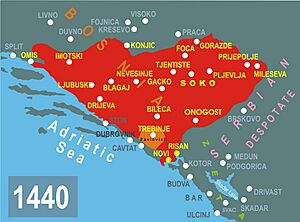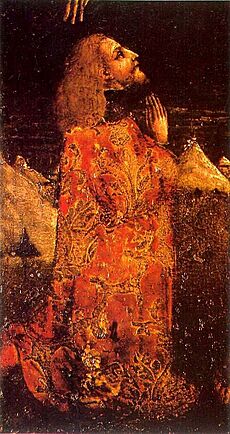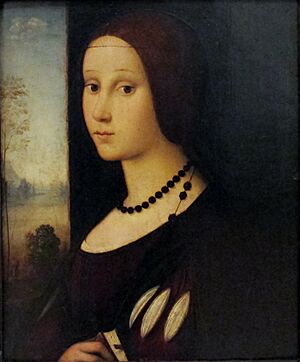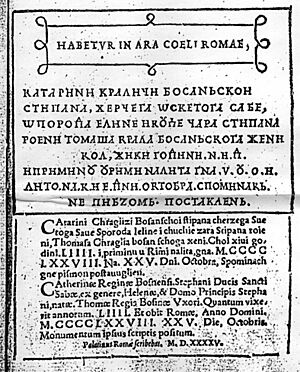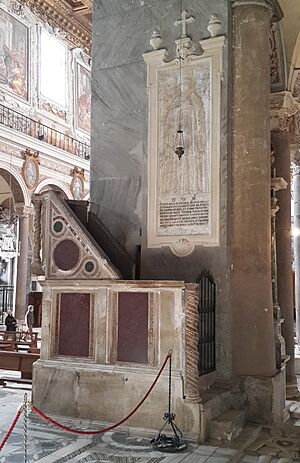Catherine of Bosnia facts for kids
Quick facts for kids Catherine of Bosnia |
|
|---|---|
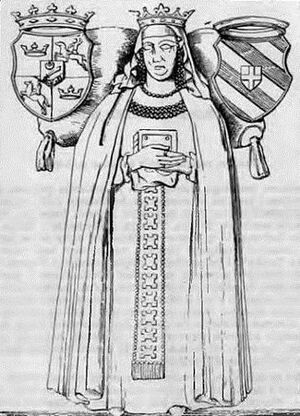
Ledger stone to Queen Catherine of Bosnia, showing the queen on a chest tomb, surrounded by her husband's and father's family symbols. (reproduction from 1677)
|
|
| Queen consort of Bosnia | |
| Tenure | May 1446 – 10 July 1461 |
| Born | 1424/1425 Blagaj, Kingdom of Bosnia |
| Died | (aged 53–54) Rome, Papal States |
| Burial | Santa Maria in Aracoeli |
| Spouse | Stephen Thomas of Bosnia |
| Issue |
|
| House | Kosača (paternally) Kotromanić (by marriage) |
| Father | Stjepan Vukčić Kosača |
| Mother | Jelena Balšić |
| Religion | Roman Catholic, convert from Bosnian Church |
Catherine of Bosnia (Serbo-Croatian: Katarina Kosača/Катарина Косача; born 1424/1425 – died 25 October 1478) was a queen of Bosnia. She was the wife of King Thomas, who was the second-to-last king of Bosnia.
Catherine was born into the powerful House of Kosača family. Her family strongly supported the Bosnian Church, a Christian group in Bosnia at the time. In 1446, her marriage to King Thomas was arranged. This marriage helped bring peace between the King and Catherine's father, Stjepan Vukčić. Before her marriage, Catherine became a Roman Catholic. As queen, she actively helped build many churches across the country.
After her husband died in 1461, Catherine became a queen dowager, which means she was the widowed queen mother. She lived at the court of her stepson, King Stephen Tomašević. Two years later, in 1463, the Ottoman Empire invaded Bosnia. The Ottoman army, led by Mehmed the Conqueror, ended the independent Bosnian kingdom. Catherine's stepson, King Stephen Tomašević, was executed. Her son, Sigismund, and daughter, Catherine, were captured. They were taken to Constantinople (modern-day Istanbul) and later became Muslims.
Queen Catherine managed to escape. She found safety in Dubrovnik and later moved to Rome. In Rome, she received money from the papacy (the Pope and his government). From Rome, she tried hard to get her children back. She tried to negotiate and offer money for their freedom, but it didn't work. She died in Rome as a Franciscan tertiary, a person who lives by Franciscan rules but isn't a monk or nun. In her will, she named the Pope as the guardian of Bosnia. She also said her children would inherit the throne if they ever returned to Christianity.
Queen Catherine is still a very important person in the history and folk stories of Bosnia and Herzegovina. She has been honored by Catholics of Bosnia and Herzegovina for a long time. Today, many people see her as a symbol for all ethnic groups in Bosnia and Herzegovina.
Contents
Early Life
Catherine was the daughter of Stjepan Vukčić Kosača. He was a very powerful nobleman in Bosnia. His lands later became known as Herzegovina. Catherine's mother was Jelena Balšić. Jelena was the first of Stjepan's three wives. Catherine was their first child. We don't know her exact birth date, but it was either 1424 or 1425. She was likely born in Sokol Fortress or Blagaj.
We don't know much about Catherine's life before she got married. Her father was a strong supporter of the Bosnian Church. Her mother was an Eastern Orthodox Christian. Catherine was raised in her father's faith.
Catherine became important when Stephen Thomas became King of Bosnia in 1443. King Thomas belonged to the Bosnian Church and was married to a woman named Vojača. They had a son, Stephen Tomašević. In 1445, King Thomas became a Roman Catholic. The Catholic Church did not recognize his marriage to Vojača. So, Pope Eugene IV allowed him to end that marriage.
A civil war had been happening between the King and Catherine's father. It ended soon after the King's conversion. To make sure peace lasted, King Thomas and Catherine were to be married. This was a great honor for Catherine's father.
Royal Marriage
The wedding ceremony followed the Catholic rules. It happened between May 19 and May 22, 1446. Catherine arrived in Milodraž with her father. A group from Republic of Ragusa (Dubrovnik) attended the wedding. However, some important noblemen did not come. The new queen became Catholic before her marriage. The Pope allowed her to choose two priests from the Bosnian Franciscans.
Catherine was very devoted to her new faith. She used her own money to build churches across Bosnia. She started with a church in Kupres in 1447. Then she built churches in Krupa na Vrbasu and Jezero. In 1458, a church was built in Jajce. She asked Pope Pius II to name the Jajce church after Saint Catherine of Alexandria. The Pope agreed. He even offered forgiveness for sins to anyone who visited her church on special days.
Catherine and King Thomas had at least two children. Their son, Sigismund, was born around 1449. Their daughter, Catherine, was born in 1453.
Queen Dowager
King Thomas died in the summer of 1461. Catherine was 37 years old and had two young children. Her stepson, Stephen Tomašević, became the new king. Catherine and Stephen Tomašević did not get along well before. This could have made the kingdom weaker against its enemies, especially the growing Ottoman Empire. So, Stephen Tomašević decided to make peace with Catherine. He promised her the title and rights of a queen dowager. Catherine likely stayed at the royal court in Jajce.
In 1462, Catherine's situation became worse. Her brother, Vladislav, rebelled against their father. He asked the Ottomans for help. The King and Catherine's father started preparing their defenses. But the King made a big mistake by angering the Ottomans even more. In the spring of 1463, the Ottoman sultan Mehmed the Conqueror and his army marched towards Bosnia.
By May, many fortresses were quickly falling to the Ottomans. The royal family decided to split up and flee. They went in different directions to confuse the invaders. Catherine found herself trapped in Kozograd Castle. Her children were captured in the town of Zvečaj and taken to Constantinople. Her stepson was tricked into surrendering in Ključ. He ordered all his castle commanders to give up their fortresses. But Kozograd did not follow his order. Its defenders held off the Ottomans while Catherine escaped. She rode to Konjic and then to the coast. She sailed to Lopud, an island controlled by the Republic of Ragusa. Catherine and Queen Maria, her stepdaughter-in-law, were the only royal family members who escaped the Ottomans.
Escape to Dubrovnik
Catherine arrived on Lopud in June 1463. The leaders of Ragusa were worried that helping the Queen might make the Ottomans attack their state. So, they did not let her into Dubrovnik until July 23. This was after her father and brothers successfully fought back against the Ottomans. In Dubrovnik, Queen Catherine tried to claim a yearly payment that Bosnian rulers received. But the authorities refused. They decided to keep the money until the rightful heir could be found. On October 26, Catherine gave Thomas's silver sword to Ragusa. She said it should only be given to Sigismund if he was freed. Soon after, she left Dubrovnik for Slano.
Catherine's family got back almost all of their land in the autumn of 1463. They even took over some former royal lands. Catherine likely went to her family's lands. But these lands were attacked by the Ottomans again in the summer of 1465. Catherine and Vladislav went to the Pelješac peninsula. Ragusa then gave them safety on one of their islands. Catherine left Ragusa for good in September 1465. She probably lived in Zachlumia or near Šibenik. Her father died in 1466.
Life in Rome
In 1467, Catherine sailed to Italy. She arrived in Ancona. By October 29, 1467, the Queen was in Rome. She was already receiving a very generous payment from the Papal State. She rented a house for herself and her group of Bosnian nobles. On October 1, 1469, she moved to a house near San Marco Evangelista al Campidoglio. Pope Sixtus IV gave her a lot of land near the Tiber river.
The Queen was an important person in Roman society. She attended the wedding of Grand Prince Ivan III of Russia in 1472. Her trip to L'Aquila for a religious event was also noted. She lived a comfortable life. Roman writers mentioned her group of 40 knights when she went on a pilgrimage in 1475.
Even with her comfortable life, Catherine was focused on getting her children back. She tried to find someone to negotiate with the Ottoman Empire. She also tried to get money for their release. In 1470, she wrote to Ludovico III Gonzaga, the Marquis of Mantua. In 1474, she wrote to the Duke of Milan, Galeazzo Maria Sforza, asking for help. Sforza agreed. In the summer of 1474, the Queen was in Novi. This city was held by her family. She was with her brother Vlatko's wife. She probably wanted Vlatko's help to contact their half-brother, Hersekzade Ahmed Pasha. He had become a Muslim and an Ottoman leader. It is not clear if she succeeded. But she failed to reunite with her children. Both of them became Muslims and held important positions in the Ottoman Empire.
Death and Burial
Catherine was disappointed that she couldn't get her children back. She returned to Rome and joined the Secular Franciscan Order. This was a group of people who followed Franciscan rules but lived in the world. Shortly before she died in 1478, she was visited by Nicholas of Ilok. He was a puppet king of parts of Bosnia controlled by Hungary. He wanted her to recognize him as the rightful king. Nicholas wrote that the sick Queen became "so angry that she looked like a sharp sword."
On October 20, 1478, Catherine made her last will. She wanted to be buried in front of the main altar of Ara Coeli church. She believed she had the right to decide about the Bosnian crown. She named Pope Sixtus IV and future Popes as guardians of the kingdom. She said they should crown her son if he became Christian again. If not, then her daughter should be crowned if she became Christian again. Most of her personal items went to her helpers. She left her chapel items to a church for Slavic people. She also said that if her son never returned to Christianity, King Thomas's silver sword in Dubrovnik should go to her nephew, Balša Hercegović. The Queen died five days after writing her will. Her will, along with her husband's sword and spurs, was immediately taken to the Pope.
Catherine was buried as she wished. But her tombstone was moved from the floor to a wall of Ara Coeli church in 1590. The original writing on her tomb was destroyed then. However, a calligrapher named Giovanni Battista Palatino had recorded it in 1545. It was unique because it was written in two languages: Latin and Bosnian Cyrillic. Only the Latin writing was put back on her tombstone today.
Legacy
Queen Catherine is one of the most famous historical figures in Bosnian folk stories. People often call her "the last queen of Bosnia." This is not quite right, as her stepdaughter-in-law was also a queen and lived longer than her. The honoring of Queen Catherine began in the Franciscan province of Bosna Argentina. This was during the time when the Ottoman Empire ruled Bosnia. After the Ottoman conquest, many Bosnians became Orthodox Christians or Muslims. The Franciscans started promoting Catherine as a symbol of Bosnia's independence and its Catholic past. This is especially true in Central Bosnia, where many folk stories about Catherine exist.
Queen Catherine's life has been a very popular topic in the history of Bosnia and Herzegovina. Historians from Croatia and Serbia have also studied her. With the rise of ethnic nationalism, historians tried to give her a specific national identity. They tried to say she was Croat, Serb, or Bosniak. But this idea doesn't fit medieval times.
Queen Catherine is becoming an important symbol for the country of Bosnia and Herzegovina. This is because she is connected to both of its historical regions. She also had close ties to Catholicism, Eastern Orthodoxy, Bosnian Christianity, and Islam. The anniversary of her death gets more attention each year. It is now marked with a "Mass for the Homeland." Schools, community centers, and groups are being named after the Queen. In 2014, an official group from the Presidency of Bosnia and Herzegovina placed flowers at her tomb for the first time. Catherine is also becoming a symbol for different ethnic groups, mainly between Catholic Croats and Muslim Bosniaks. Both groups often claim her as their own.
Images for kids


